Thrane and Thrane A S SP3515 Sailor SP3515 Hand Held VHF Radiotelephone User Manual SP3515
Thrane & Thrane A/S Sailor SP3515 Hand Held VHF Radiotelephone SP3515
user manual
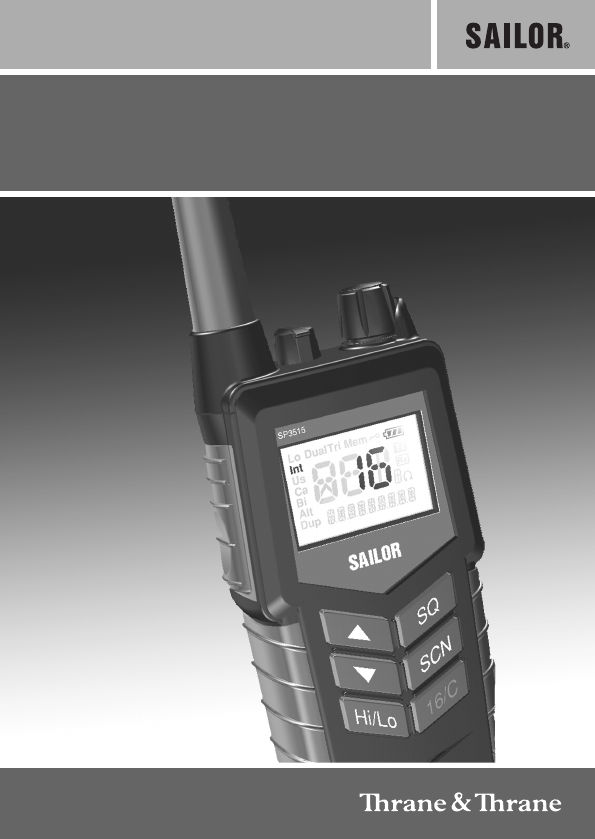
SAILOR SP3515 VHF
USER MANUAL
Emergency procedure
• Turn the knob at the top of the radio clockwise. The display lights up
showing the last used channel and the battery level.
• Select channel 16 (Distress or Safety), press the 16/C key.
• Press the PTT and say:
— “MAYDAY, MAYDAY, MAYDAY”,
— “This is”..... ships name repeated three times
—
— “MAYDAY”
— “This is”..... ships name and call sign,
— The ship’s position in latitude and longitude or other reference
to a known geographical location,
— The nature of distress and assistance wanted,
— Any other information which might facilitate the rescue.
— “OVER”
• Release PTT and listen for answer.
0709
i
SP3515 VHF
Document number: TT 98-124293-B
Release date: March, 2007
Copyright: © 2007 Thrane & Thrane A/S. All rights reserved.
Trademark Acknowledgements
•SAILOR is a registered trademark of Thrane & Thrane A/S.
•Other product and company names mentioned in this manual may be
trademarks or trade names of their respective owners.
Warranty limitation
IMPORTANT - The radio is a sealed waterproof unit. To create and maintain its
waterproof integrity it was assembled in a controlled environment using special
equipment. The radio is not a user maintainable unit, and under no circumstances
should the unit be opened except by authorized personnel. Unauthorized opening
of the unit will invalidate the warranty.
Disclaimer
Any responsibility or liability for loss or damage in connection with the use of this
product and the accompanying documentation is disclaimed by Thrane & Thrane.
The information in this manual is provided for information purposes only, is
subject to change without notice, may contain errors or inaccuracies, and
represents no commitment whatsoever by Thrane & Thrane. This agreement is
governed by the laws of Denmark.
Manuals issued by Thrane & Thrane are periodically revised and updated. Anyone
relying on this information should satisfy himself/herself as to the most current
version. Providers with access to Thrane & Thrane's Extranet may obtain current
copies of manuals at: http://extranet.thrane.com.
Thrane & Thrane is not responsible for the content or accuracy of any translations
or reproductions, in whole or in part, of this manual from any other source.
0709

ii
Precautions
Avoid water and salt in the I/O connector and keep it
clean frequently.
Only use original Thrane & Thrane battery packs. Make
sure they are clean and dry before attaching the
transceiver. Be careful not to damage any gaskets.
Only use the original Thrane & Thrane charger for the
rechargeable battery.
Be very careful when handling the Lithium batteries.
With correct use they are safe but any misuse might
cause dangerous situations.
Never short circuit the battery terminals, never expose
the transceiver and the batteries to extreme temperature
or fire and never use any kind of violence.
Avoid close contact between the antenna and parts of
the human body. The top of the antenna must never be
closer than 5 cm to the body when transmitting.
Do not submerge the transceiver more than 1 m for 30
minutes.
Keep the transceiver at least 0.3 m away from the
magnetic compass.
0709

iii
Training information
SAILOR SP3515 VHF is designed for "occupational use only". It must be operated by
licensed personnel only.
The SP3515 complies with the FCC RF exposure limits for "Occupational Use Only".
• FCC OET Bulletin 65 Supplement C, evaluating compliance with FCC guidelines
for human exposure to radio frequency electromagnetic fields.
• American National Standards Institute (C95.1) IEEE standard for safety levels
with respect to human exposure to radio frequency electromagnetic fields,
3 kHz to 300 GHz.
• American National Standards Institute (C95.3) IEEE recommended practice for
the measurement of potentially hazardous electromagnetic fields - RF and
microwaves.
Correct use
For best performance, hold the radio vertically and 10 cm away from the head when
talking into the microphone.
Warning! Your Thrane & Thrane VHF radio generates
electromagnetic RF (radio frequency) energy when
transmitting. To ensure that you are not exposed to excessive
amounts of energy and thus to avoid health hazards from
excessive exposure to RF energy, all persons must be at least
5 cm away from the antenna when the radio is transmitting.
0703
iv 0641

v
Contents
Chapter 1 Introduction
Your VHF .............................................................................1
Performance .......................................................................2
Channels ............................................................................2
Chapter 2 Operation
Controls ..............................................................................5
Keys and buttons ................................................................5
The display .........................................................................7
Using the VHF .....................................................................8
Basic functions ...................................................................8
Other functions .................................................................. 11
Chapter 3 Batteries
Battery level indication ......................................................15
Removing and inserting the battery pack ...........................15
The battery charger ...........................................................16
Installing the charger ........................................................16
Recharging the battery ......................................................17
Chapter 4 Configuring the radio
Configuration mode ...........................................................19
Entering and using configuration mode ............................19
List of configuration settings .............................................20
0703

vi
Chapter 5 Equipment and accessories
External equipment .......................................................... 27
List of equipment .............................................................. 27
Connecting external equipment ........................................ 27
Impact on radio operation ................................................28
Accessories ...................................................................... 29
List of accessories .............................................................29
Attaching and removing the belt clip ................................ 30
Attaching the lanyard .......................................................30
Chapter 6 Troubleshooting
Displaying errors ...............................................................31
App. A Technical specifications
Technical data .................................................................. 33
General ............................................................................ 33
Transmitter ....................................................................... 34
Receiver ........................................................................... 34
Battery life guidelines ...................................................... 36
Dimensional drawing, transceiver .................................... 37
Dimensional drawing, charger .........................................38
Declaration of Conformity ................................................. 39
App. B Attention
Goretex Membran ..............................................................41
0718
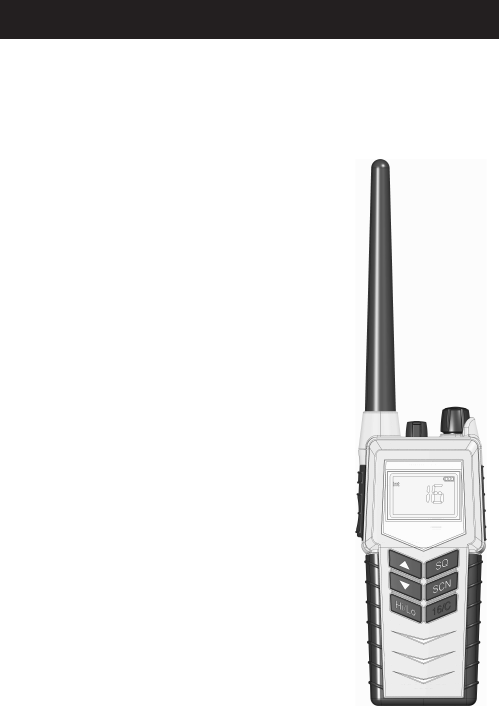
Chapter 1
1
Introduction
Your VHF
The SP3515 VHF is designed for flexibility in daily
use. It connects easily to external equipment like
headsets and fist mikes, making the SP3515
suitable for any noisy environment.
Main features:
Unique man machine interface, an excellent
grip even with gloves, and large tactile
buttons.
Display with red adjustable backlight which
makes the display visible even at night.
Built-in “sleep” function, minimizing power
consumption and improving battery lifetime.
Selectable 12.5 kHz narrow band or 25 kHz
wide band operation.
Scrambling function for privacy calls.
CTCSS function for selective opening of
Squelch.
A lanyard and belt clip included.
A huge accessory program comes with the
SAILOR SP3500 series.
Please find the nearest SAILOR distributor on
www.thrane.com.
0643

Introduction
2
Performance
For best performance of the transceiver keep the following in mind:
• Keep clear of metal environment.
• Hold the transceiver vertically and 10 cm from lips and push the PTT
when transmitting.
• In receive mode carry the transceiver vertically with belt clips.
• To preserve battery power, adjust squelch to close the loudspeaker
when there is no signal.
• If you are in a lifeboat keep the antenna as high as possible.
Channels
This radio operates with the following channels, depending on the
configuration (see the notes on the next pages):
19172560687785 US W-ch. CA W-ch.
2 10182661697886 W1 W8 W1
311192762717987 W2W9 W2
412202863728088 W3W10 W3
51321 647381 W4
61422 657482 W5
71523 667583 W6
81624 677684 W7
0709

Introduction
3
Channel modes
The notes in the following sections list the channel restrictions that apply
for each channel mode.
For information on how to select a channel mode, see
Entering and using
configuration mode
on page 19 and
CHAN
on page 20.
Please familiarize yourself with the local laws on how to operate this type
of equipment.
International channels
Note:
Tx power is limited to 1 W on channels 75 and 76.
US channels
Notes:
• TX power is limited to 1 W on channels 13, 67 and 77.
• The channels 2, 4, 60, 61, 62, 75 and 76 cannot be selected.
• The Weather channels (US W-ch. in the channel table) can only be
used in Rx direction.
• Channel 15 can only be used in Rx direction. Tx direction is blocked.
• The channels 1, 3, 5, 7, 18, 19, 21, 22, 23, 63, 64, 65, 66, 78, 79, 80, 81,
82 and 83 may only be used as simplex channels (and is marked A).
Channel 20 may be used as duplex and simplex.
0703

Introduction
4
Canadian channels
Notes:
• Tx power is limited to 1 W on channels 15, 17, 20, 65, 66 and 77.
• The channels 19, 22, 63, 75, 76 and 81 cannot be selected.
• The Weather channels (CA W-ch. in the channel table) can only be
used in Rx direction.
• The channel 21 can only be used in Rx direction. Tx direction is
blocked.
• The channels 4, 5, 7, 18, 19, 21, 22, 61, 62, 64, 65, 66, 78, 79, 80, 81 and
82 may only be used as simplex channels (and marked A). Channel 83
may be used as duplex and simplex.
Inland Waters (BI) channels
Notes:
• TX power is limited to 1 W on channels 15 and 17.
• ATIS function is enabled on all channels.
• Dual watch and Scanning modes are disabled.
ATIS is automatically transmitted after each transmission in Inland
Waters. See
ATIS
on page 18 for information on how to program the call
sign.
0709
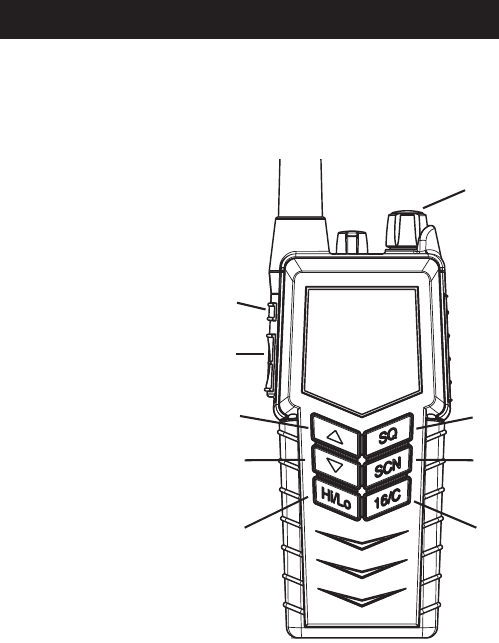
Chapter 2
5
Operation
Controls
Keys and buttons
1. On/off/volume
2. Light/Lock
3. Push To Talk (PTT)
4. Up key
5. Down key
6. Hi/Lo output power
7. Squelch
8. Scan
9. Priority channel (16)/
Call channel
1
2
3
4
5
6
7
8
9
0643
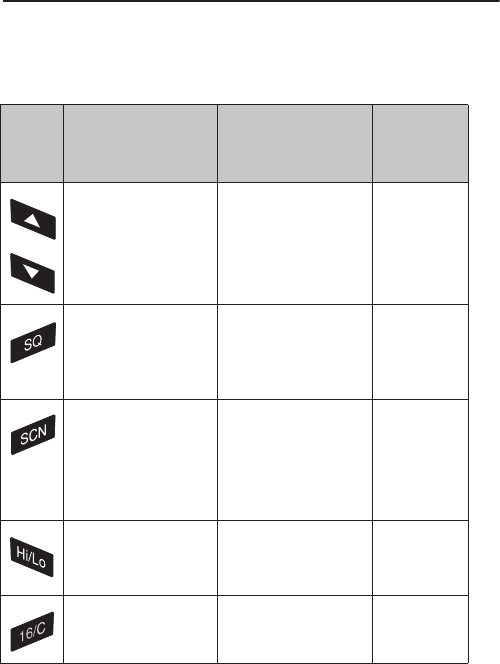
Operation
6
Key presses
Pressing and holding certain keys gives access to additional functions,
shown in the table below.
Key Short press
(1 beep)
Long press
(2 beeps)
Extra long
press
(3 beeps)
Show next available
item in the list (up or
down).
Default: Channel
selection
Run through available
items, or
select tagged channels
A (T) or B (S).
Run through
available
items if an A
or B channel
is tagged
Activate Squelch
control (Adjust with
up/down arrows).
Monitor function. Open
Squelch completely.
Set period of time in
configuration mode.
1 press: Activate/
terminate Dual/Triple
watch.
2 presses: Activate
memory scan.
Add/Delete channel
from memory scan.
Toggle between high
and low transmitter
power.
Select channel 16. Select programmed
Call channel.
Program Call
channel.
0703
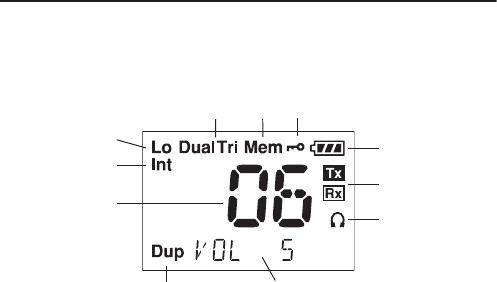
Operation
7
The display
The display holds various fields of information, explained below.
1. Current working channel.
2. Current channel mode.
3. “Lo”: Reduced transmitter power.
Full transmitter power is not shown in display.
4. Dual/Triple watch activated.
5. Current working channel is marked for scanning.
6. Keypad is locked.
7. Battery level indicator.
8. Transmitting (Tx) /Receiving (Rx).
9. Accessory is connected.
10. Service line for various purposes. In this example the volume level.
11. Duplex channel.
1
3
456
7
8
9
10
2
11
0703
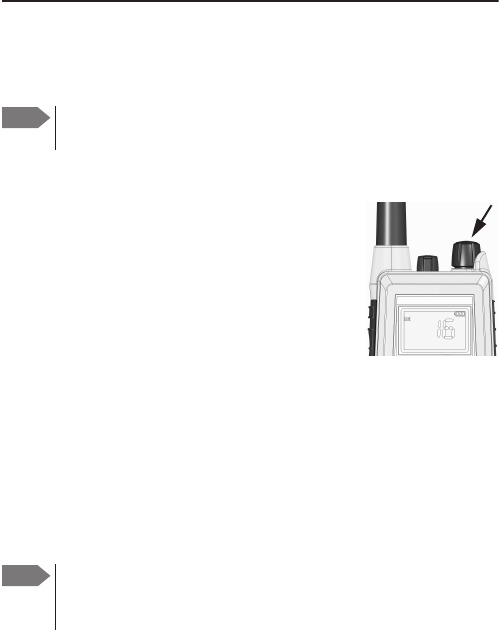
Operation
8
Using the VHF
Basic functions
Switching the radio on and off
•To switch the radio on, turn the knob at the top
of the radio clockwise.
The display lights up showing the last used
channel and the battery level.
•To switch the radio off, Turn the knob back
counter-clockwise until it clicks.
Selecting the working channel
• To select channel 16 (Distress or Safety), press the 16/C key.
• To select the Call channel, use a long press on 16/C.
• To select among all available channels, press S or T on the keypad.
For fast selection, press and hold S or T.
The display shows the currently selected channel. The bottom left corner
of the display shows “Dup” if the channel is a duplex channel.
Note Before using the radio, mount the antenna at the top of the
radio. The antenna is delivered with the radio.
Note Long press on S or T can also be used to select preferred
channels. For information on how to program preferred
channels, see
Configuring the radio
on page 19.
0643
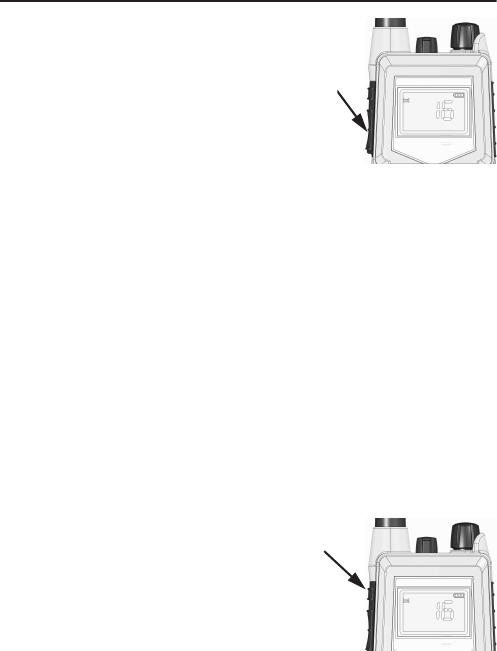
Operation
9
Activating a call
To activate a call to the selected channel, press and
hold the PTT button on the side of the radio.
The radio transmits as long as the PTT button is
pressed. A small Tx sign next to the channel num-
ber indicates when the radio is in transmit mode.
Adjusting the volume
•To increase the volume, turn the on/off knob at the top of the radio
clockwise.
•To decrease the volume, turn the knob counter-clockwise.
The display shows the level of the volume, e.g. “VOL 5”, while it is
adjusted.
Using Squelch control
•To activate Squelch control, press the SQ key.
•To set the Squelch level, press S (closing) or T (opening). The
display shows the Squelch level while it is adjusted, e.g. “SQ 5”.
Adjusting the display backlight
•To turn on the backlight, press the
Light/Lock button on the side of the radio.
•To adjust the backlight level, press S or T
within 3 seconds after turning on the light.
The display shows the level while it is
adjusted, e.g. “DIM MED”.
0643

Operation
10
Using Dual/Triple watch
•To activate Dual/Triple watch, press the SCN key.
The display shows “Dual” or “Tri” at the top and “16” at the
bottom right. The radio toggles between the selected channel and
channel 16 in Dual watch. In Triple watch, the radio shifts between
channel 16, the call channel and the selected channel.
To select whether the SCN key should activate Dual or Triple watch,
refer to
Configuring the radio
on page 19.
•To terminate Dual watch, press SCN again.
Scanning channels
•To activate channel memory scanning, press 2 times SCN within 2
seconds.
During scanning, the display shows “SC” in the channel field. The
radio toggles between channel 16 and each of the channels marked
for scanning.
•To terminate scanning, press SCN once.
Changing the transmitter power
To change the transmitter power, press the Hi/Lo key. The display shows
“Lo” when power is set to low. Otherwise maximum power is used.
Locking the keypad
•To lock the keypad, press and hold the Light/Lock button. The display
shows a key symbol when the keypad is locked.
•To unlock the keypad, press and hold the Light/Lock button again.
0703

Operation
11
Other functions
Programming the Call channel
To program the Call channel, do as follows:
1. Press and hold 16/C until the current Call channel number is flashing.
2. Select the channel with S or T.
3. Press 16/C to confirm.
Programming the channel memory
To add a channel to the channel memory, select the channel and then
press and hold the SCN key until the display shows MEM at the top.
To remove a channel from the channel memory, select the channel and
then press and hold the SCN key until the MEM sign disappears from the
display.
Low power operation
The radio can be operated in low power mode. In this mode battery life
time is dramatically increased. Up to the first second of a received call
might be lost if this mode is selected. Refer to
SLEEP
on page 21.
Continuous Tone Coded Squelch System
On channels where it is allowed, you can set up selective squelch
opening by sub-tone detection (CTCSS), using the configuration mode
(see
CTCSS
on page 24). Please note that if the radio is operating with
CTCSS on a channel, it is impossible to receive a normal signal on that
channel. For this reason, be very careful not to use CTCSS programmed
channels in emergency situations. Channels programmed with CTCSS will
0643

Operation
12
have a clear identification in the service field, e.g. "CTCSS 22", while
selected. Not all channels are allowed for CTCSS use.
In maritime channel modes CTCSS is automatically disabled when
• Product is turned off
• A new channel is selected
For private channels and ALT channel mode, the feature will remain until
manually removed.
Scrambler
On channels where it is allowed, you can set up voice scrambling, using
configuration mode (see
SCRM
on page 25).
Please note that if the radio is operating with scrambling on a channel, it
is impossible to communicate with other radios that are not programmed
with the same scrambler code. For this reason, be very careful not to use
scrambled channels in emergency situations. Scrambled channels will
have a clear identification in the service field, e.g. "SCRM 3", while
selected. Not all regions allow the use of voice scrambling.
In maritime channel modes scrambling is automatically disabled when
• Product is turned off
• A new channel is selected
For private channels and ALT channel mode, scrambling will remain until
manually removed.
Narrow band operation
The radio is prepared for narrow band operation. If narrow band
operation is selected (see
BAND
on page 25), the number of channels are
doubled in the maritime channels, according to international
0703

Operation
13
recommendations. Refer to the channel table in
Channels
on page 2.
Channels are clearly identified with a preceding 4- or 2-digit, while
operating in narrow band mode. Narrow band radios will not always be
completely compatible with wide band operating radios.
0703

Operation
14 0703
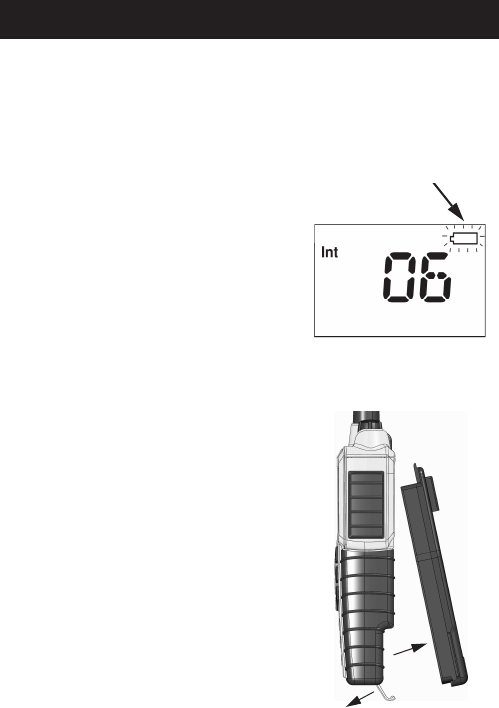
Chapter 3
15
Batteries
Battery level indication
When the battery level is low, you should recharge the battery.
The radio display shows the battery
status. When the battery symbol is empty
and flashing, the battery should be
recharged as soon as possible.
Removing and inserting the battery pack
To remove the battery pack, do as follows:
1. Open the safety lock as shown.
2. Remove the battery.
To insert the battery pack, attach the battery
and then close the safety lock.
1
2
0643
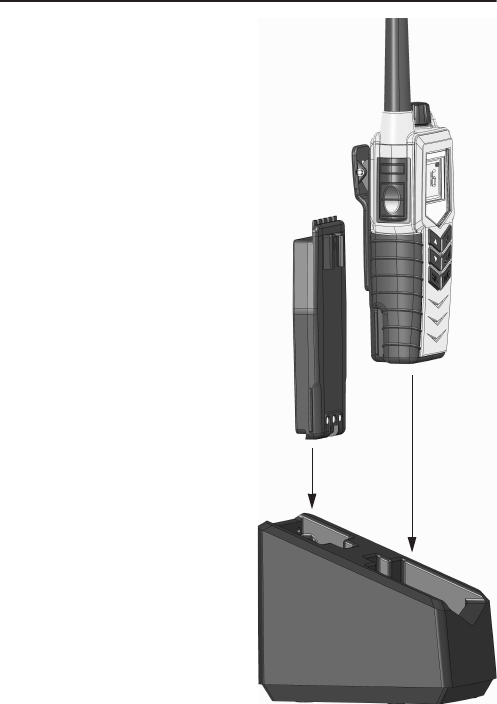
Batteries
16
The battery charger
The charger has two compartments.
• A rear compartment for storing a
spare battery. It does not have a
charger function.
• A front compartment for
recharging the battery alone or
while attached to the radio.
Installing the charger
Mounting the charger
There are several options for
mounting one or more chargers on a
table or a wall.
For information on dimensions and
screw positions, refer to
Dimensional
drawing, charger
on page 38.
When mounting the charger, make
sure it is placed in a dry place and
away from direct sunlight. The
charger is not waterproof.
0643

Batteries
17
Connecting to power
The charger can be supplied from DC or from AC using an AC/DC
converter.
DC: Connect the 12-24VDC Connection Cable between the DC supply and
the connector on the underside of the charger.
AC: Connect the AC/DC converter to the connector on the underside of the
charger. Then connect the AC/DC converter to the AC outlet.
Recharging the battery
To recharge the battery, place the radio1 with battery or the battery alone
in the front position of the charger cradle.
The light indicators on the charger cradle show the status as follows:
• Green light: Power is connected to the charger.
• Slow red flash: Charging in progress.
• Quick red flash (twice per second): Charging error, e.g. battery defect
or temperature out of range.
• Steady red light: Charging completed. Trickle charge mode.
Charging time with emtpy battery: VHF off
approx. 4 hours, VHF on: approx. 5 hours.
If the radio is on during the charging
process, the battery indicator in the upper
right corner of the display shows that the
battery is charging.
1. The radio may be left on or it may be switched off during the recharge
process
0709

Batteries
18 0643

Chapter 4
19
Configuring the radio
Configuration mode
Entering and using configuration mode
•To enter configuration mode, press and hold the Light/Lock button
while turning on the radio.
The bottom line of the display shows the current menu item/setting.
•To exit configuration mode, turn off the radio or press any key except
S, T and the Light/Lock button.
Using the PTT button or leaving the radio inactive for 10 seconds also
causes the radio to exit configuration mode.
•To change a setting, press S or T.
•To confirm the current setting and go to the next menu item, press the
Light/Lock button.
Note The radio is not operational in configuration mode.
0643

Configuring the radio
20
List of configuration settings
The following settings are available in configuration mode.
Name Values Description
LIGHT MAN Only Light/Lock button activates the backlight.
KEY All keys and buttons, except PTT and volume
control, activate the backlight.
CHAN INT International channels.
US US channels.
CA Canadian channels
BI Inland waterways. ATIS and ATIS killer is
enabled. All multiple watch is disabled.
ALT Custom defined.
BEEP MAX Status click/beep sound on key press, long
press (settings/programming saved) and
battery alarm. Maximum level.
MIN Status click/beep sound on key press, long
press (settings/programming saved) and
battery alarm. Minimum level.
OFF All beeps off.
VER X.XX.XX Software version. Read-only.
BAT X.XX Battery voltage (V). Read-only.
TEMP XX.X Temperature (°C). Read-only.
0703

Configuring the radio
21
SLEEP ON Enable sleep mode (to minimize power
consumption).
Sleeps for periods of 1 second after 15 seconds
of idle mode. Idle mode is: no signal detected
and no operation of the radio.
OFF Disable sleep mode.
CONTRST 1, 2, 3, 4, 5 Contrast.
1 = lowest and 5 = highest.
SHANG OFF Off. Resumes scanning when signal
disappears.
4, 6, 8, 10 Scan hang time (in seconds) on an active
receiving working channel. The time is
measured from signal detected - remains on
channel even if signal disappears.
WTCH DUAL Single press on the SCN key activates Dual
watch.
TRI Single press on the SCN key activates Triple
watch. If no CALL channel is programmed,
“Dual” watch is activated.
SQ TIME A long press on SQ opens squelch. The squelch
level resumes to setting 3 seconds after SQ is
released.
MAN A long press on SQ opens squelch. The squelch
level resumes to setting as soon SQ is released.
Name Values Description
0703

Configuring the radio
22
WORK ON If the distress or call channel is selected using
the 16/C key, any push on S or T will select
the working channel active when 16/C was
pushed.
OFF If on a distress or call channel, any push on
S or T will select the channel next to the
displayed channel.
ATIS NONE Default state if not programmed.
Push S to go into programming mode.
READ The ATIS call sign is programmed and
available for read-out.
Push S to read the programmed ATIS value.
DDDADDDD ATIS Call sign read-out. Read-only after
programming once. Changing or clearing the
Call sign after programming is only possible
via the service interface.
Name Values Description
0643

Configuring the radio
23
1 _ _ _ _ _ _ _ _ 0-9 In ATIS programming mode:
• Select the digit position with the Light/Lock
button.
• Select the digit with S or T.
1 2 _ _ _ _ _ _ _ 0-9
1 2 3 _ _ _ _ _ _ 0-9
1 2 3 A _ _ _ _ _ A-Z
1 2 3 A 5 _ _ _ _ 0-9
1 2 3 A 5 6 _ _ _ 0-9
1 2 3 A 5 6 7 _ _ 0-9
1 2 3 A 5 6 7 8 _ 0-9
1 2 3 A 5 6 7 8 S Press S to confirm programming.
Note: All digits must be programmed.
PREFA OFF Remove tag “A” for current working channel.
ON Tag current working channel with “A”. If
another channel was previously tagged “A”,
this is overruled.
• The working channel can now be selected
with a long press on T.
PREFB OFF Remove tag “B” for current working channel.
ON Tag current working channel with “B”. If
another channel was previously tagged “B”,
this is overruled.
• The working channel can now be selected
with a long press on S.
Name Values Description
0643

Configuring the radio
24
CTCSS OFF CTCSS disabled.
ON Activate CTCSS on working channel. Two radios
on the same channel and with SUBC enabled,
can have a certain level of privacy.
Note that if you choose this option, the radio
immediately exits configuration mode and
starts CTCSS on the working channel.
SUBC OFF SUBC disabled. Squelch opens on all received
signals.
1, 2, ..., 38 Sub-tone carrier ID.
Squelch opens if the received signal contains
the desired subtone. During transmission the
sub-tone with the corresponding ID is
generated.
Two radios on the same channel and with the
same sub-tone ID, can reduce unwanted
incoming traffic from other users on the same
channel.
GROUP SEL Selective Mode. Squelch opens only if the
programmed sub-tone is received in the
signal.
ANY Squelch opens on reception of any of the 38
sub-tones.
Name Values Description
0703

Configuring the radio
25
SCRM OFF Scrambler disabled.
ON Activate scrambling on working channel. Two
radios on the same channel and with
scrambling enabled, can have a certain level of
privacy.
Note that if you choose this option, the radio
immediately exits configuration mode and
starts scrambling on the working channel.
SCODE OFF No scrambler code is assigned to the channel
(selecting “ON” in the SCRM setting will have
no effect).
1, 2, 3, 4,
5, CC
A selection between 5 fixed sets of scrambler
characteristics, and a custom code (CC), can be
assigned to the channel.
Note that the custom code can be defined in
the service interface.
BAND 25.0 Wide band operation selected.
12.5 Narrow band operation selected.
• Intercepted channels will be denoted 2XX.
• Standard maritime channels will be denoted
4XX.
Name Values Description
0703

Configuring the radio
26 0703
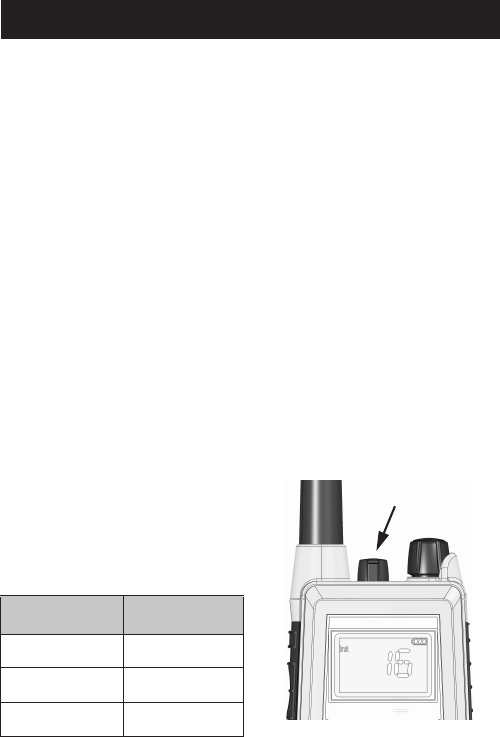
Chapter 5
27
Equipment and accessories
External equipment
List of equipment
The following equipment can be connected to the radio:
• SAVOX 400E Push-To Talk unit
• SAVOX C500 Fist Mike
• SAVOX NC/400 Noise-com
• SAVOX HC-E Helmet-com
• SAVOX K53004 Helmet unit
• Peltor MT7H79 Headset
We recommend to remove all accessories during emergency use.
Connecting external equipment
Connect the dedicated interface cable
between the external equipment and
the top connector on the radio.
Interface cable Order number
For SAVOX 400E 403500-940
For SAVOX C500 403500-950
For Peltor FL5214 403500-951
0703

Equipment and accessories
28
When external equipment is connected
to the radio, the right side of the display
will show a headset.
Impact on radio operation
The external equipment can have a built-in PTT, speaker and
microphone. Thus connecting it to the radio will have the following
impact on the radio operation:
• If a microphone is built into the detected external equipment, the
external equipment microphone is used, and the internal radio
microphone is disabled.
• If a speaker or earpiece is built into the detected external equipment,
the external equipment sound device is used, and the internal radio
speaker is disabled.
• If a PTT or VOX is built into the detected external equipment, the
external equipment PTT control is used, and the radio PTT button is
disabled.
0703

Equipment and accessories
29
Accessories
List of accessories
The following accessories are delivered with your radio:
Batteries, charger, AC/DC Converter and 12VDC Connection are described
in Batteries on page 15.
To mount the antenna, simply screw it into the threaded bush at the top
of the radio.
Accessory Part number
Secondary battery (black, rechargeable), B3502 403502A
Charger, CH3507 403507A
AC/DC converter, length 150cm (100-240V~ /12VDC out) 88-124371
12-24VDC Connection cable, length 150cm 37-124381
Belt clip 62-124320
Antenna 88-124370
Lanyard 41-124375
SP3515 User Manual (this manual) 98-124293
0703
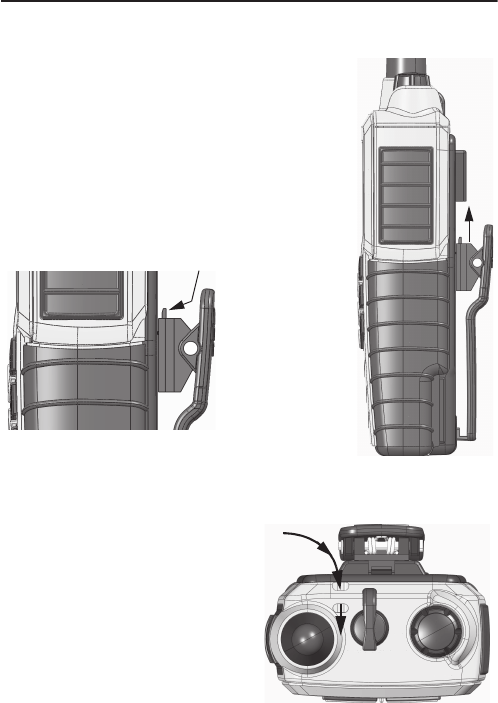
Equipment and accessories
30
Attaching and removing the belt clip
To attach the belt clip, slide the belt clip upwards
into the rails at the back of the radio until it locks.
To remove the belt clip, press the projection at
the top of the belt clip to release the lock and
slide the belt clip downwards out of the rails.
Attaching the lanyard
Do as follows:
1. Take the lanyard through the
eye at the top of the radio.
2. Put one end of the lanyard
through the loop at the other
end of the lanyard and pull to
tighten.
Release lock
Top view
0643

Chapter 6
31
Troubleshooting
Displaying errors
Some errors result in an error message in the display. These error
messages are listed below.
Display text Problem Type Actions
Err
EMPTY BAT
The battery voltage is
below a critical level,
where further operation
would damage the battery.
Severe.
Radio is non-
functional.
Change/recharge
the battery.
Err
HW ERR
Hardware error. Severe.
Radio is non-
functional.
Service required.
ILLEGAL
Context fails operation.
This text will appear on
the following occasions:
•Multiple watch is
selected on channel 16,
or in channel regions
where it is not allowed.
• High power is selected
on a channel where it is
prohibited.
• Transmission on
blocked channels
Fail
operation
Consider operation
in a different
context.
0703

Troubleshooting
320703

Appendix A
33
Technical specifications
Technical data SP3515
General
Item Specification
RX frequency range 148.000 - 174.000 MHz
TX frequency range 148.000 - 174.000 MHz
Modulation
25 kHz
12.5 kHz
16K0G3E
8K50G3E
Power supply 7.2 VDC Li battery
Current drain at 5 W TX 1.7 A
Current drain at 1 W TX 0.8 A
Current drain RX max audio 0.25 A
Battery Lithium-Ion, 1800 mAh rechargeable
Operating temperature -20°C to +55° C
Water ingress protection IP67
Frequency stability Better than ±0.7 kHz
Weight with emergency battery 340g
0709

Technical specifications
34
Transmitter
Receiver
Item Specification
RF output power 5 W /1 W
Max deviation
25 kHz
12.5 kHz
±5 kHz
±2.5 kHz
Spurious emission < 0.25 uW
Adjacent channel power
25 kHz
12.5 kHz
> 70 dB
> 60 dB
Item Specification
Sensitivity (20 dB SINAD) -117 dBM typical
Intermodulation
25 kHz
12.5 kHz
> 68 dB
> 65 dB
Spurious response > 70 dB
0643

Technical specifications
35
Adjacent channel selectivity
25 kHz
12.5 kHz
> 70 dB
> 60 dB
Audio output, internal 0.25 W at 10% dist.
Audio output, external 0.25 W/8 Ohm
Item Specification
0709

Technical specifications
36
Battery life guidelines
During daily use, always keep the battery fully charged and away from
hot areas.
Keep the battery terminals dry and clean.
Never discharge beyond the specifications of the battery.
Operation/Standby time depends on usage. Generally, the more the radio
is transmitting, the faster it will drain the battery. Also, the “Hi” power
setting will drain the battery faster than the “Lo” setting.
Approximate figures are:
• A battery can be stored for 4 to 6 month at 25°C if charged to 25%.
• The battery will normally last for 5 to 9 hours of use on a fully
charged battery.
Note New batteries should be placed in the charger for minimum 12
hours first time.
0709
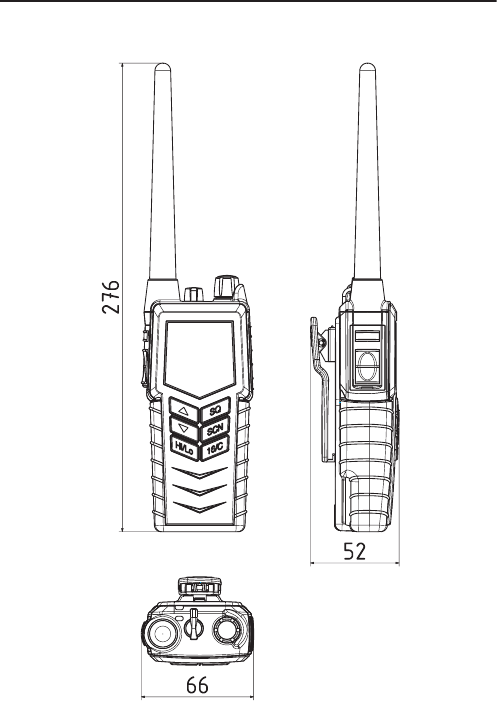
Technical specifications
37
Dimensional drawing, transceiver
0643
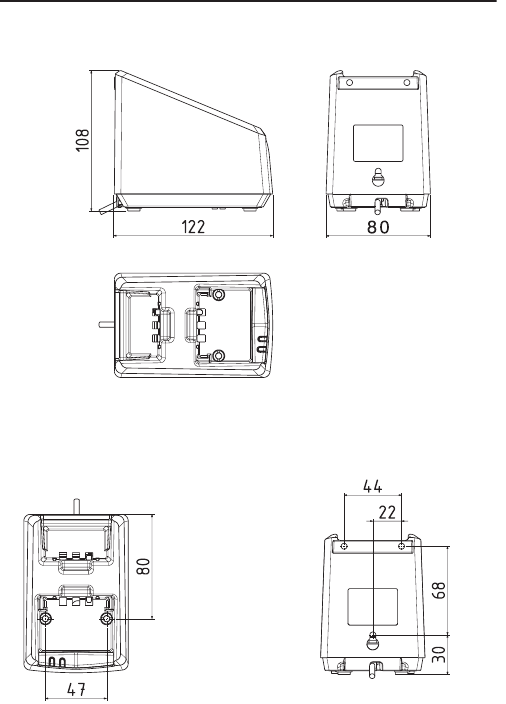
Technical specifications
38
Dimensional drawing, charger
Mounting Possibillities
Desktop mounting, top view Wall mounting, rear view
0703
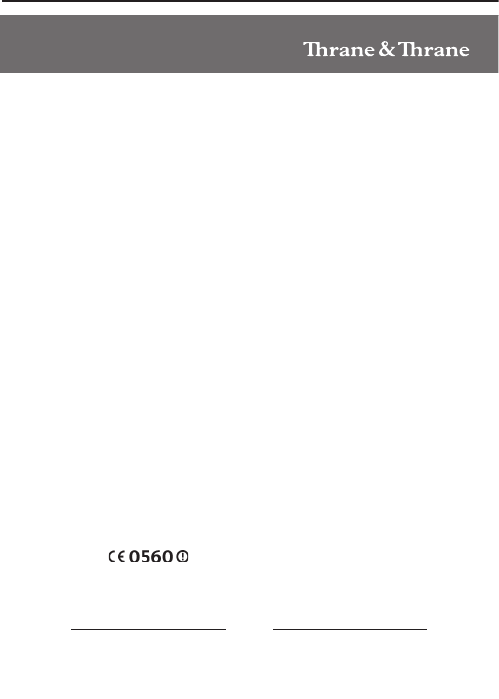
Technical specifications
39
Declaration of Conformity
R&TTE
Date Chief Executive Officer
Henrik Lunde
Doc. no TT99-124499-A
xx.xx - 2006
DECLARATION OF CONFORMITY
Thrane & Thrane A/S
Porsvej 2
9200 Aalborg SV
DK-Denmark
We, as manufacturer, herewith declare that the following equipment complies with the
specifications of the RTTE directive 1999/5/ EC
Equipment
SAILOR VHF Radiotelephone
Consisting of:
SP3510 Portable VHF Radiotelephone
SP3515 Portable VHF Radiotelephone
B3502 Rechargeable Li-Ion Battery
CH3507 Battery Charger
Equipment Applicability
SAILOR SP3510 and SP3515 are simplex/semi-duplex handheld VHF radiotelephones designed for
maritime communication within the frequency range 155 MHz to 163.425 MHz.
Declaration
SAILOR SP3510 and SP3515 conform to the RTTE directive with respect to
Article 3(1)(a) the protection of health and safety
Article 3(1)(b) electromagnetic compatibility requirements
Article 3(2) effective use of the spectrum and avoidance of harmful interference
Which is shown by conforming to EU harmonized standard EN 301 178-2, EN 60945-Ed. 4.0,
EN 60950 and EN 300 698-3.
Statement no.
Telefication: xxxxxx/xx-xx
Notified Body:
Preliminary
0643

Technical specifications
40
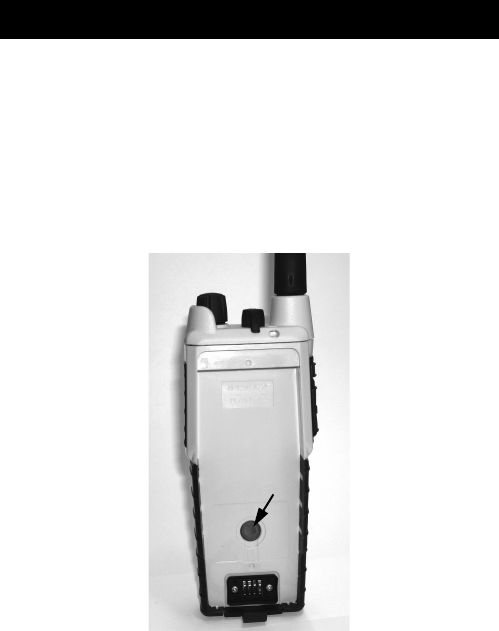
Appendix B
41
Attention
Goretex Membran
To keep the VHF watertight, is it very important that the goretex membran
behind the label under no circumstances must be damaged or removed.
0709

Attention
42 0709

TT-98-124293-C Issue: C/0718
Thrane & Thrane A/S • info@thrane.com • www.thrane.com